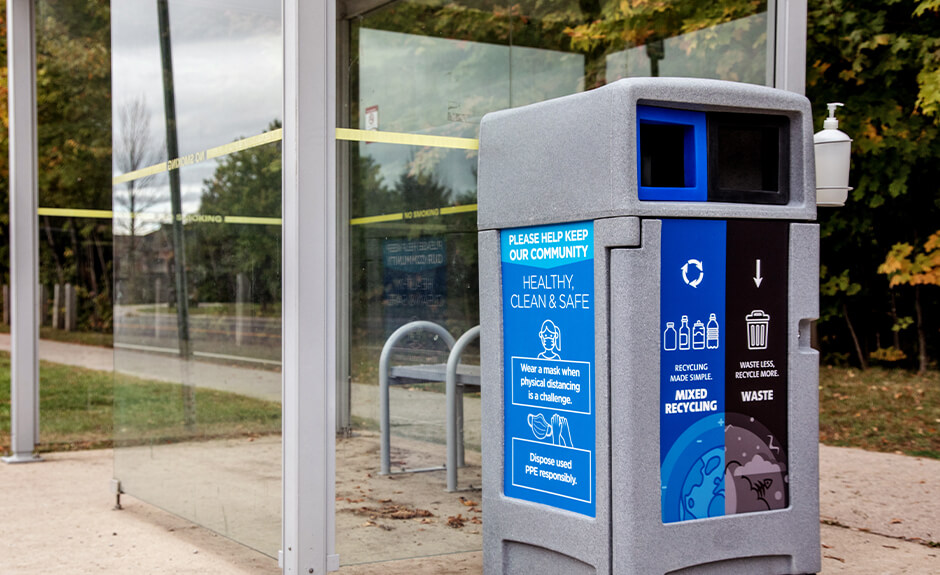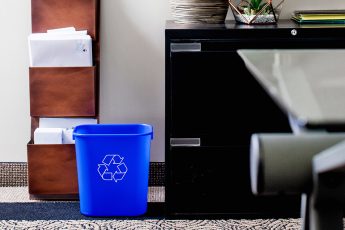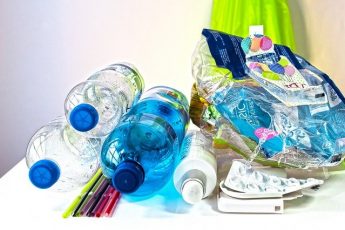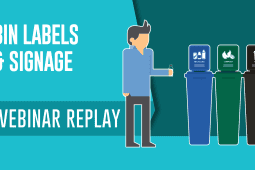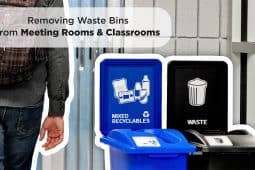Communities Making Public Space Recycling Work
I’ve studied recycling in public spaces for a number of years. I’ve watched webinars and read case studies. I’ve networked with folks around the US and Canada. I’ve read many studies and even commissioned a few. But when I’m periodically asked to name the top outdoor public space recycling programs, ones that have solved problems like contamination or low participation in parks or downtown areas, I don’t have any to offer. I can point to communities that have put serious effort into building and refining these programs. Despite this investment, the program managers involved will invariably tell you they still struggle with the common challenges others face.
Recycling isn’t easy, and parks, downtown areas and other outdoor public spaces are arguably the most difficult setting to do it. You don’t have to look far to find stories of 50% or more contamination. The largely uncontrolled nature of these public spaces subjects bins to heavy wear and tear. The market slump for scrap recyclables in recent years has undermined the economics of collection programs, which are tenuous in the best of times.
And yet communities continue to invest in these programs. A core driver, of course, is to increase diversion. But for many, the stronger consideration is marketing, both to sell the community and recycling itself. Recycling bins on a street corner are a direct way to reinforce the perception that recycling is a “full-time” activity one does whether at home, work or taking the kids to the neighborhood playground. It’s also a strong way to project a community’s values as an inviting and forward-thinking place. The question isn’t which communities have the best programs, but rather which ones have developed strategies to negotiate common obstacles and deliver on these objectives.
By that measure, I’ll point to three programs that have impressed me:
- Parish of East Baton Rouge (BREC), LA
- City of Austin, Parks and Recreation Department, TX
- Operation Downtown, Des Moines, IA
Public Space Recycling Programs That Standout
Let’s start with some background on each.
BREC – Baton Rouge, LA
Formally referred to as The Recreation and Park Commission for the Parish of East Baton Rouge, this agency oversees a wide range of over 170 parks and other public facilities covering most of Louisiana’s capitol city. According to BREC’s Assistant Director of Natural Resource Management, Amanda Takacs, the agency first launched recycling using 55-gallon drums at a sports park in 2014. Grants from Keep America Beautiful and it’s Louisiana affiliate allowed them to introduce recycling at four large community parks. With these early efforts providing the “proof of concept”, the parks commission in 2018 agreed to fund an expansion of recycling that now includes a total of ten community parks and sports facilities. Further plans call for extending the program to the remaining five larger community parks and a handful of conservation areas in the coming years. Recycling is just one element of the agency’s Geaux Green initiative, which is tasked with pursuing strategic sustainability goals around energy and waste conservation, sustainable building design and environmentally preferable purchasing among other areas.
City of Austin Parks & Recreation (PARD), TX
The City of Austin has had a high profile in the recycling industry in recent years as a rare example of a major southern city pursuing an aggressive zero waste by 2040 goal along with a broad range of initiatives in the residential and commercial sectors, as well as public spaces. The city’s parks and recreation department, or PARD in shorthand, had long recycled at indoor facilities and special events when it adopted a three-phase waste diversion plan in 2016 to expand collections to all 300+ parks and other facilities. Hired as the zero waste manager in 2019, Meredith Gauthier is driving this ambitious agenda which includes a now-completed phase one expanding recycling coverage to athletic complexes, golf courses and metro parks. Phase two, which she expects to complete in 2022, is focused on larger district parks. Phase three will target the broader network of neighborhood parks and any remaining facilities. Other plans on the horizon call for introducing food organics collections from special events and eventually back-of-house operations at recreation facilities.
Operation Downtown, Des Moines, IA
While BREC and Austin’s recycling efforts cover a range of different urban and suburban park and recreation settings, Operation Downtown’s waste reduction program, as the name implies, focuses squarely on the streetscape, urban squares and public spaces in downtown Des Moines. Chartered as a 501(c)6 business improvement district (BID), Operation Downtown launched their Recycle DSM initiative as a pilot with eight bins in the city’s Historic East Village neighborhood in 2016. Their executive director Amy Lego, participated on an April 2021 Busch System’s webinar, where she detailed the subsequent expansion to approximately 70 locations and a strategy to continue adding roughly 10 new bins a year in the downtown area.
All three recycling programs focus on collecting cans and plastic bottles while explicitly excluding glass containers. While paper is collected with local residential programs, all three steer away from collecting it in public spaces because of the relatively low volume and difficulties communicating the complexities of recyclable and non-recyclable paper in on-the-go locations.
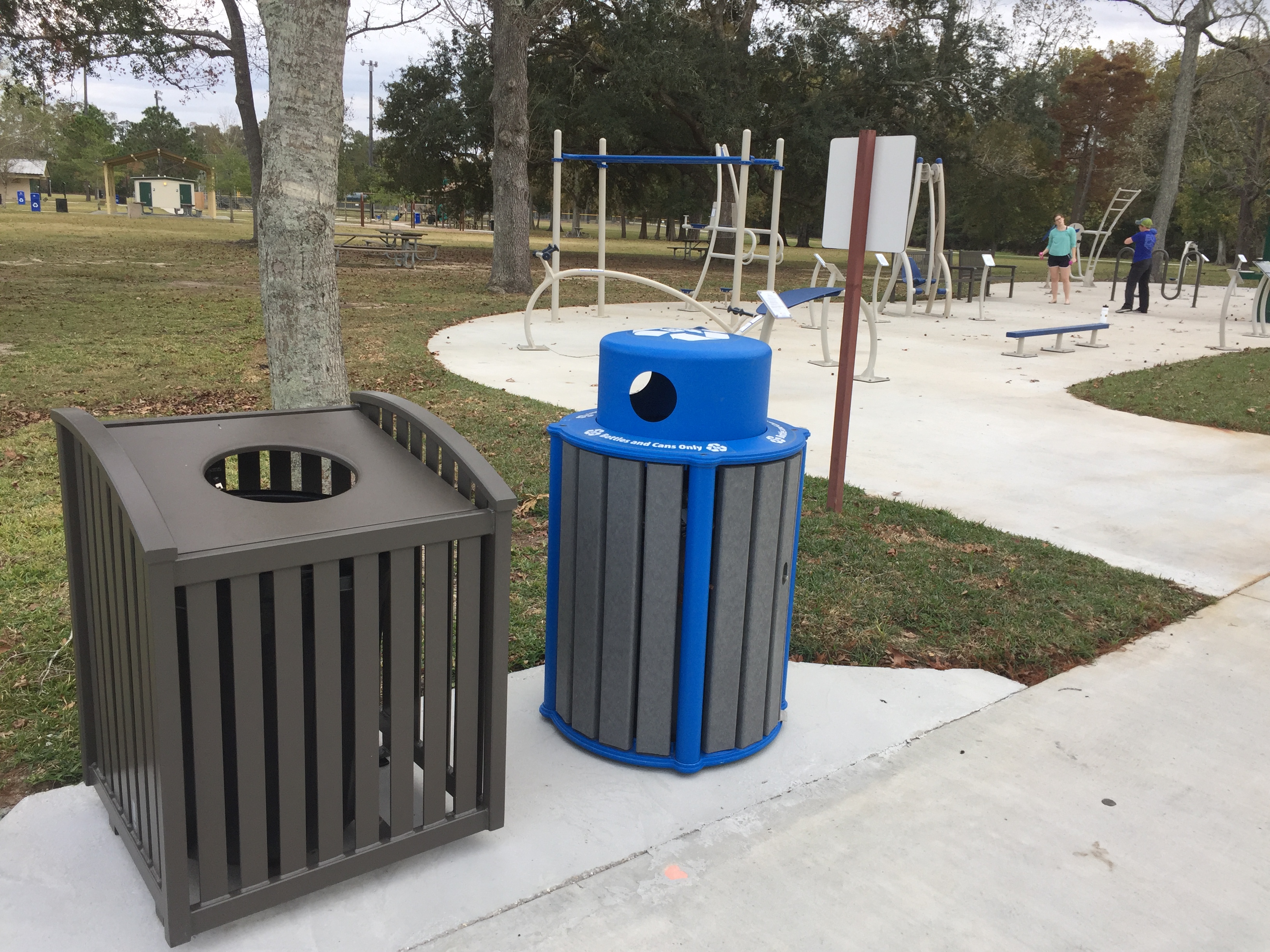 Trash & Recycling Bins used by BREC
Trash & Recycling Bins used by BREC
Building Collection Infrastructure Around Best Practices
Each of these programs has made a point to design their bin infrastructure around established best practices to encourage correct recycling. All three apply a consistent color scheme using blue for recycling and black for trash. As new bins are added or replaced, each is working to standardize around one or two specific styles to reinforce visual consistency between locations. Similar to many universities, Austin has gone so far as to produce formal specification and installation guidelines to direct new purchasing in the future. All three programs subscribe to the twin doctrines of restrictive openings and pairing recycling and trash bins immediately next to other in all locations. BREC’s embrace of these design standards followed a familiar trial and error pattern. Early on, Takacs said, the department’s architects insisted on an attractive but ill-suited style of bin that generically presented trash and recycling with the same black and white colors and large unrestricted openings. Between the high contamination and dilapidated appearance caused by heavy use, decision makers eventually conceded the need for a more practical style of bin.
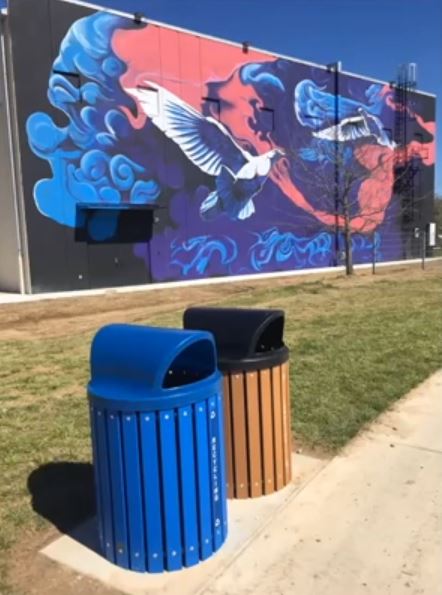 City of Austin trash and recycling receptacles
City of Austin trash and recycling receptacles
Working with Stakeholders to Implement New Recycling Program
Most public space recycling programs require adapting a legacy infrastructure and collection system designed to handle trash only. That process involves complexities, and at times, negotiating with stakeholders who’ve built a routine around the old system. Deciding on bin design is one example. Another sticking point can be deciding where to place them. Similar to many communities, Meredith Gauthier inherited a program with trash bins spread across facilities in a seemingly random, uncoordinated fashion. One of her early tasks was to map the placement and condition of existing bins throughout Austin’s network of park and other facilities using photographs, GIS and asset management software. Her process of expanding recycling to new locations involves several steps to re-evaluate and at times alter the placement of bins. It starts with a walk through to understand where bins are or should ideally be placed in relation to points of waste generation like picnic areas or parking lots, as well as restrooms and other park features. Another step is to look at collection records to understand the volume of waste being generated in relation to the capacity of available bins and the frequency of collection service.
A third step is to consult district managers and their collection crews. This one is important not only because the local staff have valuable knowledge of a park’s usage patterns, but because they are, after all stakeholders and have their own opinions about where bins should be placed. And that can lead to tension. In my own experience, local park crews often default toward the need for more bins spread widely to minimize litter and ensure sufficient capacity to handle peak waste generation occasions. And no question, there’s hard science showing the relationship between convenient placement (or lack of) and litter behavior. Recycling coordinators, though, understand placement patterns also influence recycling participation and contamination, not to mention the financial challenge of purchasing additional recycling bins to place next to seemingly redundant trash receptacles. Balancing these separate and sometime conflicting placement dynamics isn’t always easy. Gauthier and Takacs both cited the importance of building trust with grounds crews and approaching the issue as a long-term process of give and take. Takacs’ general strategy is to accept imperfect legacy trash locations in the short term while negotiating new, more recycling-friendly placement patterns as parks are renovated and new ones built.
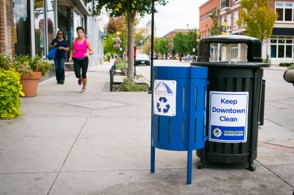 Photo courtesy of the Greater Des Moines Partnership
Photo courtesy of the Greater Des Moines Partnership
For Gauthier, the process is a mixture of trial and error, and suggesting alternate arrangements. Instead of maintaining redundant bins to handle the extra waste from heavy use occasions like special events, she encourages district managers to roll out portable light weight bins as needed. Working together, the Austin team has been experimenting with a concept that any public works administrator would consider the holy grail of waste management: a pack-it-in, pack-it-out system that eliminates both trash and recycling bins while instructing visitors to take waste items with them. Previous pilots have shown mixed results. It’s worked successfully in smaller pocket parks and certain nature trail locations, and in fact there are active plans to expand the practice to similar locations. Traditional city parks with picnic areas, playgrounds and other amenities? Not so much. Like other communities, PARD has found that special signage and outreach couldn’t overcome ingrained expectations, and that removing bins from larger, multiple use settings resulted in significantly more litter.
Incorporating recycling into the waste collection process can generate its own resistance, not to mention confusion. For both Austin and Des Moines this included early pushback about additional workload from collection crews who argued that despite there being no change in the overall volume of waste, dividing it into separate trash and recycling streams added an additional step to their routine servicing public-facing bins. In both cases, time and simply getting used to a new system has helped resolve these issues. Lego says that her crew of 22 paid “ambassadors” has come around to supporting the program as they see people use and express enthusiasm for the recycling bins.
Baton Rouge avoided the need for separate trash and recycling service routes by having park staff collect both streams together. To keep things streamlined and avoid recyclables getting mixed with trash, Takacs has found success using color-coded bag liners that allow staff to collect everything with the same cart and then later separate them into the appropriate back-of-house dumpster. She also conducts in-person trainings as recycling bins are introduced to new locations followed by continual monitoring over the following six months. Once the new arrangement settles-in, Takacs has found that veteran staff help to communicate expectations to new employees. A separate issue with their hauler mixing trash and recycling dumpsters in the same trash truck was resolved with a discussion and reference to the terms of the service contract.
Contamination and Other “User Errors”
The greatest challenge for waste collection from outdoor public spaces is the public itself. The uncontrolled nature of parks and downtown areas can expose bins and the surrounding infrastructure to all manner of abuse. Located in a state with a beverage container deposit system, Des Moines faces a steady stream of people picking through the bins to collect cans and bottles. While other communities place locks on bins to keep people out, Operation Downtown chooses to just let people take them. Though it means giving up the container’s redemption value and the ability to fully track diversion, Lego says surrendering a couple dollars worth of cans simply makes sense balanced against the extra labor steps to lock and unlock them, not to mention the cost to repair bins that have had lids forcibly pried off.
Contamination, of course, is the bane of all outdoor public space recycling efforts. All three programs have done audits that found contamination rates ranging between 10% and 25%, and in some cases as high as 50%. Gauthier said higher contamination rates as well as litter around the bins is often an issue of people using the recycling bin or leaving waste items on the ground when trash bins overflow. In theory this can be addressed by rightsizing bin and service arrangements over time, but PARD has found overflowing bins remain an issue on busy summer days and holiday weekends when staff capacity simply can’t keep up with park usage. As a rear-guard action, collection crews are trained to look for and toss out heavily contaminated bags to prevent fines levied by their dumpster hauler for dirty loads.
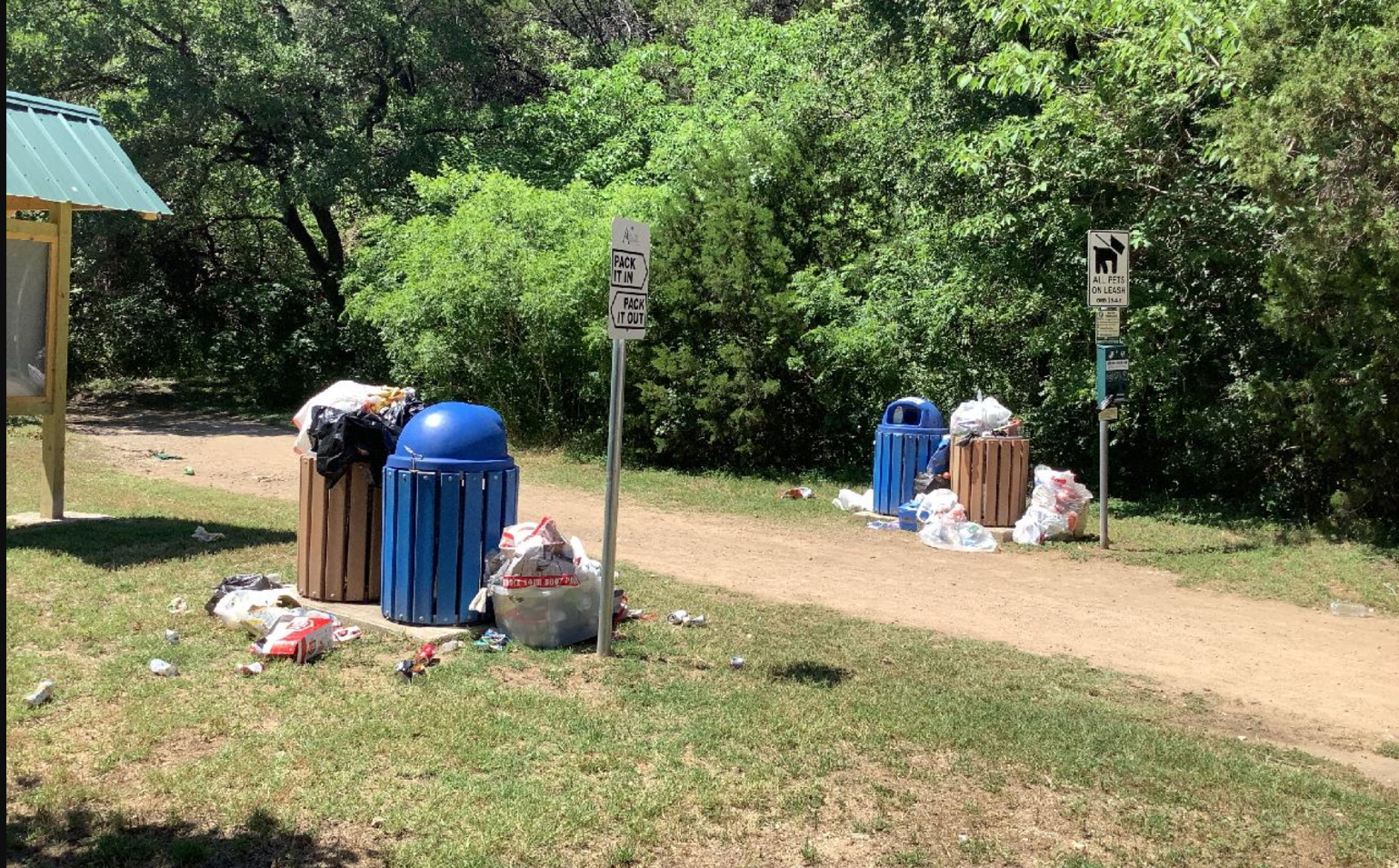 Photo courtesy of the City of Austin PARD
Photo courtesy of the City of Austin PARD
Some contaminants are universal. Amanda Takacs said the biggest issue for the Baton Rouge parks was glass bottles, largely because of confusion with the residential recycling system that still accepts them. Gauthier cited another common problem item: doggy waste bags placed in recycling bins or simply left on the ground as litter. Austin has been able to mitigate this in some locations by setting out separate, specially marked receptacles for dog waste (They’re also developing a “There Is No Poop Fairy” campaign to address the waste simply left on the ground). Some contamination issues can be very localized. Deep in the heart of Lousiana, crawfish boils are popular for social occasions. Takacs has learned to place trash and recycling bins at some distance from picnic areas, but still within eyesight. With bins immediately next to the tables, she found people were simply to casual dumping the crawfish waste into whichever bin was in reach. Walking a short distance to use the bins gives people a few moments to focus their attention and aim for the trash.
Education & Outreach
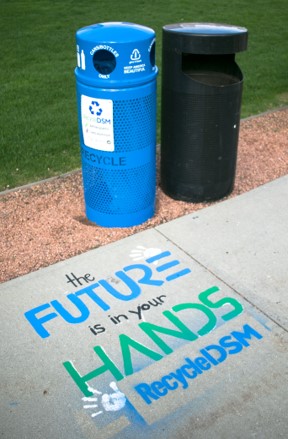 Photo courtesy of the Greater Des Moines Partnership
Photo courtesy of the Greater Des Moines Partnership
The ultimate key to reducing recycling contamination is raising awareness to address confusion. As anyone involved with public space programs knows, however, it’s no easy way to engage people passing through public spaces. All three communities look for opportunities where they exist. In addition to being a large source of beverages containers, both BREC and Austin prioritized sports fields because of the opportunity to target recycling information to participants via the sports leagues. Operation Downtown’s (Des Moines) outreach efforts include visits to neighborhood to-go eating establishments and food trucks, asking them to post flyers for customers to see. Operation Downtown and BREC both use the areas in and around the bins to raise awareness when first introducing recycling bins to a new location. BREC puts out lawn signs with program information or humorous messages, while Operation Downtown has done elaborate chalk art murals to draw attention. Operation Downtown has gone the additional step of holding a PR event to draw media attention to the recycling program.
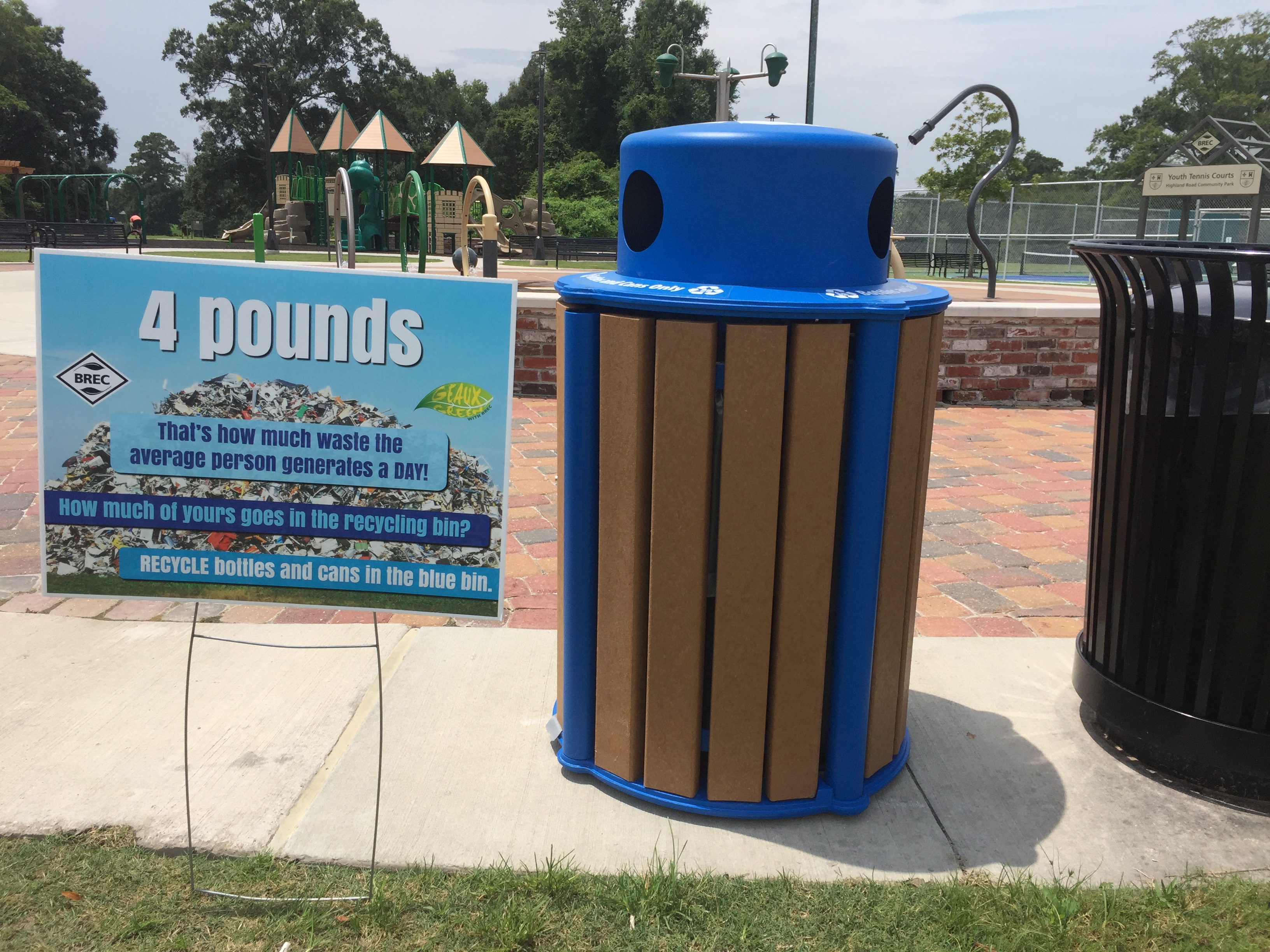 Lawn signs used by BREC when introducing new recycling bins
Lawn signs used by BREC when introducing new recycling bins
Lessons Learned
I asked all three what lessons they would share with other communities. BREC’s Amanda Takacs spoke about the process of getting buy-in from leadership. One driver was pursuit of CAPRA accreditation from the National Recreation & Parks Association (NRPA), which requires a recycling or zero waste plan (view BREC’s plan). But actually earning the kind of robust support to make that plan a reality required several years of pursuing grants and demonstration pilots that helped prove the program’s viability. Takacs also reinforced the importance of internal staff training and ongoing monitoring. Amy Lego and Meredith Gauthier both underlined the critical need to plan bin infrastructure based on design best practices like “twinning” the bin, standardizing around uniform, color coded bin styles, and well thought out placement and sign messaging. Gauthier puts a premium on getting good baseline generation and composition data for planning a new program, and having a system to track performance over time. Lego echoed this point in talking about how waste audit data drove Operation Downtown’s decision to redesign signage to call out certain contaminants and ultimately drop paper from the program to simplify their messaging. Effective programs take more than simply setting out recycling bins. They require having a plan to monitor and make adjustments as necessary over time.
Making Recycling Work
The physical appearance of a park or downtown area says a lot about a community. Local governments and commercial improvement districts go out of their way to leverage these spaces as a form of visual marketing, to project an image and even a set of values to the outside world. The city I live in in South Carolina is typical of many. They’ve developed several new high-profile parks in the past decade that feature, among other things, a world-class playground (Oh to be a kid again!), attractive site furnishings, an acre of work out installations and yes, a handful of nice-looking, high-end recycling bins. But the recycling effort is essentially an empty gesture. The program may have been set up in good faith, but it’s clear the administrators in charge eventually threw up its hands in the face of high contamination and low recycling participation. The issue isn’t so much that the program was poorly designed. Without a recycling background many planners make the same kinds of rookie mistakes: recycling bins indistinguishable from trash, small, discreet labels, three times as many trash bins as recycling… placed separate from each other in many cases. The problem is that they’ve made no effort to try to address these problems in the intervening years. The recycling bins remain in place as window dressing, but they’re treated by the department as excess capacity for trash.
Returning to an earlier point, successful recycling programs aren’t defined by collecting high-volumes of really clean material. Rather, the programs to learn from are those that test and refine their arrangements to address obstacles. What impresses me about these three community programs is their commitment to building viable recycling programs in situations where other communities set low expectations and accept underperforming status quo. While some may have more resources and support than others, BREC, Operation Downtown and Austin’s PARD each approach their recycling programs with a dynamic spirit, ready to learn lessons and continuously improve their program. Until the magical day arrives when everyone is a perfect recycler, the experience of these communities points the way for others to make recycling actually work.
Looking for more public spaces recycling case studies and resources? Check these out:
- City of Austin PARD’s zero waste event planning guide
- City of Austin PARD policy on acceptable recyclable items
- Presentation slides and recordings from past Busch System webinars:
- April 2021 – Presentations from Des Moines, IA, North Vancouver, BC and Orange County, NC
- February 2022 – Presentations from Seattle, WA and research on litter and bin placement best practices
- Another blog from Alec Cooley about bin features and specification to look for with outdoor waste bins
